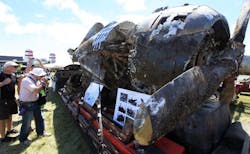Sunken Warbird Emerges From Lake Michigan in Time for EAA AirVenture
Aug. 01--OSHKOSH -- William Forbes didn't like cold water.
An unexpected swim in Lake Michigan in late December will do that to a guy. Especially a 20-year-old who grew up in sunny California.
But on Dec. 28, 1944, Forbes powered up the engine of a Grumman FM-2 Wildcat and took off along the deck of a ship converted into an aircraft carrier for naval pilots to practice carrier takeoffs and landings. Just as he reached the end of the deck, the engine quit. And the Wildcat, with Forbes strapped inside, plunged off the ship.
Forbes survived; the Wildcat did not.
The aircraft sank in 200 feet of water -- where it stayed, slowly becoming encrusted with rust, algae and zebra and quagga mussels until December when it was hauled from the depths of Lake Michigan.
Among the gleaming, lovingly restored World War II planes on display at EAA AirVenture this week is Forbes' Wildcat, its wings and tail dismantled and lying behind the fuselage on a flatbed trailer. Despite the fabulous old warbirds nearby, the rusted Wildcat hulk is drawing large crowds entranced by the exposed mechanical gear and the story of the resurrected flying workhorse.
Just how the Wildcat ended up in Lake Michigan is due partly to the nearby training facility. With the Navy's aircraft carriers on war duty, officials came up with an ingenious idea to train the 17,000 naval pilots who passed through Glenview Naval Air Station in Glenview, Ill., by turning a couple of former passenger liners in southern Lake Michigan into floating flattops.
Taras Lyssenko and his Michigan-based company A&T Recovery have pulled up from the depths dozens of World II planes over the years.
The Wildcat on display at AirVenture is mostly intact with a ripped-off tail that had settled near the plane's wreckage.
"I don't know how the pilot survived. It was about 15 degrees outside. It looks like the ship ripped the tail off as the plane went into the water," said Lyssenko, who has never displayed a plane he recovered at AirVenture before. "He probably went down with the aircraft knowing the ship was running over him, and he probably held his breath and then popped out in the freezing water.
"He was either the luckiest pilot that day or the most calm, composed pilot that day," Lyssenko said.
As a kid growing up in Fresno, Calif., Forbes was fascinated by aviation. And when he enlisted in the Navy, he trained to fly fighter planes like the Wildcat that was integral early in the war, especially at the Battle of Midway.
Stories of a lifetime
"He didn't talk a whole lot about the war, but we heard many stories regarding that incident," his daughter, Chris Smith, said of the Lake Michigan crash. "The few words all of us kids remember was that he had never been so cold."
All of the sunken World War II aircraft are still owned by the Navy and permits to retrieve the planes are issued by the Naval History and Heritage Command.
Race to restore
Though Lake Michigan's cold, dark water is a great storage facility, the quagga mussels that have invaded the Great Lakes are slowly degrading the World War II planes. In a race for time, Lyssenko estimates he has eight to 10 years to retrieve more warbirds until they disintegrate.
Forbes died of cancer in 2008 at the age of 85. After the war, he returned to Fresno, earned a law degree, worked as a lawyer handling adoptions and contracts, got married and raised three children.
He never piloted a plane again, telling his family that after the excitement and danger of war, flying a private plane just wouldn't have provided the same thrill.
Had he lived to see the plane that landed him into the icy cold water of Lake Michigan pop back up like a wayward cork, Forbes would have been shocked.
"I could just see the smile on his face and a twinkle in his eye," said Smith. "He would have been flabbergasted. And so proud."
The World War II FM-2 Wildcat recovered from Lake Michigan will be displayed in the Warbirds area of EAA AirVenture through Sunday.
Copyright 2013 - Milwaukee Journal Sentinel
